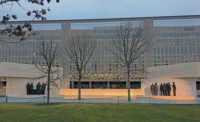Sited on the south lawn of the Ohio Statehouse, the $2.1-million Ohio Holocaust and Liberators Memorial stands as a monument to the six million Jews who perished in the Holocaust. It also honors Ohio liberators who freed thousands from the death camps in the spring of 1945.
Visitors to the memorial first encounter a sloped pathway of red-gray granite flanked by stone benches and a graduated stone wall. A subtle line emerging from the path guides visitors to a pair of 18-ft-tall bronze forms positioned at 45 degree angles to one another, the line ascending to bisect a cut-out hexagram lined with stainless steel.
Inscribed on the monument is the story of two cousins, both Auschwitz survivors, one of whom saved the other by transferring a black star to his forehead.
Project architect Studio Daniel Libeskind collaborated closely with fabricator A. Zahner Co., Kansas City, Mo., to fashion the monument's complex forms and surfaces, employing 3D engineering to render them as finished product. The two also worked in tandem to select color and patina for the metals, including Angel Hair stainless steel.
For the monument wall and benches, contractor Turner Construction Co. and Statehouse architect Schooley Caldwell Associates located rare Ohio limestone in the field of a fabricator involved in Statehouse renovations in the 1990s. Cleveland Marble and Mosaic Co., Cleveland, engineered, fabricated and installed the stone.
Prior to construction, crews pre-assembled the monument at Zahner's studio.
Planners placed particular emphasis on coordinating the position of the monument and surrounding plaza in accordance with the column line of a below-grade parking structure on site.
During the project's planning phase, a licensed surveyor pinpointed precise positions of the column grid. After all formwork was in place, a second survey was performed to ensure the accuracy of the layout prior to pouring the foundation.
Excavation to the underlying roof deck proved deeper than anticipated and required the benching of soils. To ensure proper benching, crews refrained from excavating portions of the foundation until the remainder was placed and backfilled.
Sitework occurred over a period of seven months, from November 2013 to June 2014, during which trades referenced iPads loaded with finished documents, zooming in on details to ensure accurate, quality craftsmanship.








Post a comment to this article
Report Abusive Comment